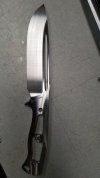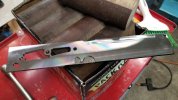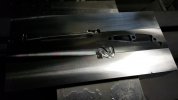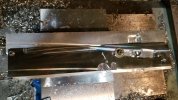- Joined
- Oct 24, 2020
- Messages
- 31
If these were your only options for surface grinding, which would be more accurate if I was going to hand sand on a granite surface plate after?
The BladeForums.com 2024 Traditional Knife is available! Price is $250 ea (shipped within CONUS).
Order here: https://www.bladeforums.com/help/2024-traditional/
Got it, so a disc grinder would be better for heat-treated steel?That very much depends on the rigidity of the mill you'll be fly cutting with. Sloppy spindle bearings and gibs/ways will make for a lot of sanding. And don't try to hard machine with a fly cutter...
You can get fairly accurate flatness, parallelism on a disc grinder with practice and patience. If you need real accuracy a surface grinder is the correct option
Don't even try to fly cut hardened steel with a knee mill
been planning on get one one of these days likely 2 or 2.5 inch im thinking depending on the cutterr style 3 inch woudl be too much for my bridgeportActually, fly cutters are pretty lame. I would recommend a decent face mill and just use a single insert. It works way better, trust me. But I still wouldn't recommend that on hardened steel.
Is there a reason not to use all the inserts? You have me curious now!Actually, fly cutters are pretty lame. I would recommend a decent face mill and just use a single insert. It works way better, trust me. But I still wouldn't recommend that on hardened steel.
The inserts will have slightly different depths and diameters and will also have higher horsepower and rigidity needs. It is slow, but you will get your best finish with a single insert and you won't overwhelm a small machine with just one.Is there a reason not to use all the inserts? You have me curious now!




Nice, thanks for the explanation! I never thought about only using one.The inserts will have slightly different depths and diameters and will also have higher horsepower and rigidity needs. It is slow, but you will get your best finish with a single insert and you won't overwhelm a small machine with just one.
View attachment 1934310View attachment 1934309View attachment 1934306View attachment 1934308
.005" death of cut and feed per revolution is a pretty good starting place for a finish cut
